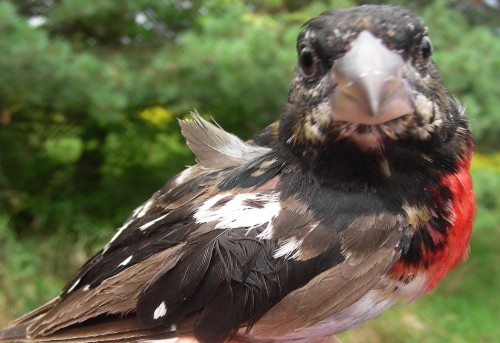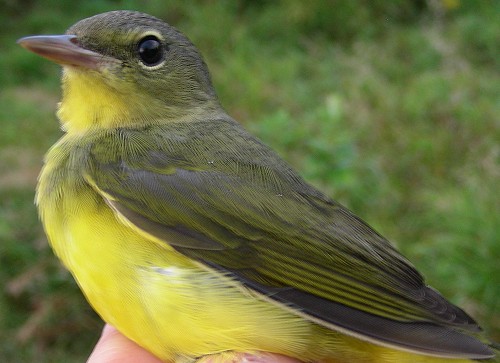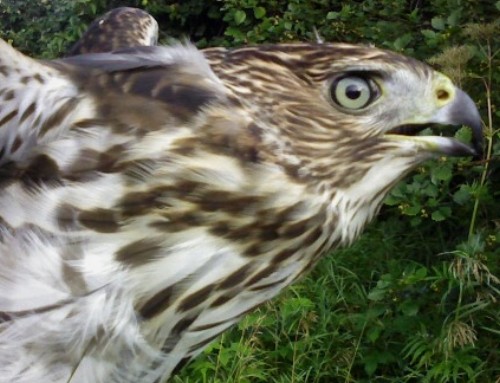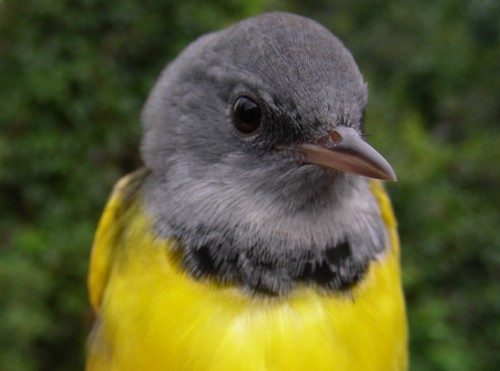|
|
THIS WEEK |
THIS FALL |
2007 TOTAL |
SITE TOTAL |
|
# birds (and species) banded |
91 (25) |
443 (41) |
1227 (71) |
10545 (101) |
|
# birds (and species) repeat |
41 (16) |
122 (26) |
237 (33) |
1786 (56) |
|
# birds (and species) return |
6 (4) |
22 (7) |
107 (23) |
307 (28) |
|
# species observed
|
84 |
99 |
145 |
189 |
|
# net hours |
493.6 |
1325.6 |
3825.25 |
17848.0 |
|
# birds banded / 100 net hours |
18 |
33 |
31 |
59.0 |
|
|
Note: table does not include nocturnal banding (owls) |
|
Banders-in-charge: Marie-Anne
Hudson, Barbara Frei
Assistants: Jean Beaudreault, Sophie Cauchon, Shawn Craik, Jean
Demers, Emily Gray, Gay Gruner, Geneviève Lussier, Sarah Marteinson,
Chris Murphy, Jen Pearson, André Pelletier, Julie Pépin, Greg Rand,
Clémence Soulard, Rodger Titman
Notes: Well, if the first week of the fall season began
with a bang, this week began with a whisper. The number of birds
gracing us with their presence dropped off significantly, giving us time
to do some much-needed site maintenance. Despite the lack of birds in
the nets, though, we were quite happy to see many species for the first
time this fall – and in a couple of cases the first time ever! The
following species were newly banded this fall: Swainson’s Thrush,
Eastern Phoebe, Great-crested Flycatcher, Brown Thrasher, and Mourning
Warbler. We won’t list the new species observed for fall because there
were 15, making for a very long list indeed. Two species we must
highlight though are Common Moorhen and Clay-colored Sparrow, bringing
the list of birds seen at MBO up to 189 species! Any predictions as to
what number 190 will be?
Despite the much lower number of birds banded,
there were 11 more species observed this week than last week, and five
more than at this time last year. But while the species count was
impressive, most were present in small numbers – and even those tended
to show little interest in visiting our nets this week. In fact,
further proof of it being a quiet week is that just four individuals
banded were enough to make the top ten list!
This week’s top ten species banded is – surprise,
surprise -- quite different from last week’s top ten. Four species have
been added, but to have the American Redstart at the top is unheard of
at MBO. Rose-breasted Grosbeak is back on the list again, and Mourning
Warblers have made their appearance, a bit of an anomaly for a
relatively uncommon species. We were also surprised to see Swainson's Thrush eke its way on to the bottom of the list this week. Strangely enough, the number of Song
Sparrows has plummeted, and we can’t figure out why. We’ll keep our
eyes and ears open and will get back to you with possible answers…
hopefully! Common Yellowthroats have ‘tchacked’ their way up to third
place. Baltimore Orioles are all but gone, as opposed to last year when
they were in second place. We’re hoping that the Magnolia Warbler rush
will begin soon, as it did last year at this time.
|
This week’s
top 10
[last week’s rank in brackets]
|
#
individuals banded |
mean # individuals observed daily |
|
1.
American Redstart (12)
[2] |
1.
American Crow (54)
[1] |
|
2.
Song Sparrow (9)
[1] |
2.
American Goldfinch (24)
[2] |
|
3.
Common Yellowthroat (8)
[9] |
3.
Black-capped Chickadee (17)
[6] |
|
4.
Rose-breasted Grosbeak (8)
[-] |
4.
Tree Swallow (11)
[-] |
|
5.
Yellow Warbler (6)
[5] |
5.
Common Grackle (10)
[7] |
|
6.
Mourning Warbler (5)
[-] |
6.
Song Sparrow (10)
[4] |
|
7.
Red-eyed Vireo (5)
[6] |
7.
American Robin (9)
[5] |
|
8.
Black-capped Chickadee (4)
[7] |
8.
Gray Catbird (8)
[10] |
|
8.
House Wren (4)
[-] |
9.
Cedar Waxwing (8)
[3] |
|
8.
Swainson's Thrush (4)
[-]
8. Nashville Warbler (4) [9]
|
10.
Ring-billed Gull (7)
[9] |
|
This
week’s top ten species observed is similar to last week’s, and
remarkably different from last year’s at this time. The Bobolinks that
we were expecting (since they made the top ten last year at this time)
haven’t arrived – likely due to the field being planted in alfalfa this
year rather then left fallow (with leftover corn from the year before).
A surprising inclusion on the list is Tree Swallow, seen streaming over
the site early in the week, along with Barn Swallows, Purple Martins and
the occasional Northern Rough-winged Swallow. The only constants are
the gang of American Crows flying back and forth from the Arboretum to
the trees lining the fields to the east, and the ever-present American
Goldfinches zipping around feeding their young.
|

This second-year male Rose-breasted Grosbeak was netted this
week, showing how scruffy young males can look. Normally
second-year can’t be determined for passerines in fall
(hatch-year or after-hatch-year being the only options in most
cases), but this guy has clearly retained his juvenile brown
plumage and is only now moulting into his spiffy adult plumage.
(Photo by Marie-Anne Hudson)

We couldn’t very well give the older male Mourning Warbler all
the glory … this hatch-year male looks an awful lot like a
Common Yellowthroat. The key: a greyer head and a broken
eye-ring, plusyellow extending across the entire underparts
(Photo by Marie-Anne Hudson)

And finally, we figured out how to get photos off a cell phone!
Here’s the young (hatch-year) male Cooper’s Hawk from last week
– he was very well behaved.
(Photo by Marie-Anne Hudson)
|




